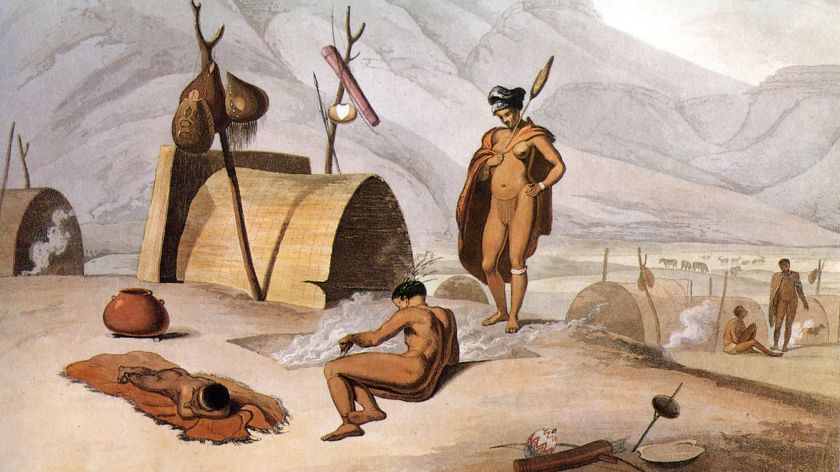‘Linnaeus was definitely a racist’
-
 'Khoisan besig om sprinkane te braai' (1805). Aquatint door Samuel Daniell (Wikimedia Commons)
'Khoisan besig om sprinkane te braai' (1805). Aquatint door Samuel Daniell (Wikimedia Commons)
OPINION - There were definitely racist aspects to Linnaeus' classification of races, according to Josias Tembo, PhD candidate in philosophy and Kiki Kolman, political sciences alumna. For example, in Linnaeus' opinion, the Khoi and San peoples of South Africa were not human. This classification gave a scientific legitimacy to colonial violence.
Thanks to the open letter written by candidate AKKUraatd party leader Sarah Boulehoual, the discussion about the name of the Linnaeus building has been reopened. So last week, Vox asked Willem Halffman, senior lecturer in Science & Technology Studies, just how racist Linnaeus actually was. We disagree with his answer – that it’s overreacting to call a biologist racist.
Linnaeus is the founder of biological taxonomy. He put together a classification in which he divided plants, animals and humans into categories. Halffman is correct in saying that Linnaeus determined the division based on geographical areas: the ‘white’ Europeans, ‘yellow’ Asians, ‘red Americans’ and ‘black’ Africans. Not only that, but Linnaeus believed that the difference in skin colour was the result of various climates in the geographical regions. However, the fact remains that this geographical division was closely interwoven with racism, in his time, and so not at all free from hierarchy.
The Swedish biologist did not write his work in a vacuum. Colonial and racial thinking had already conquered the world in the eighteenth century. The Netherlands, for example, had colonies in Suriname, South Africa and Indonesia and the transatlantic slave trade was in full swing. Geographical regions were strongly associated with different types of people. Racist ideas formed the justification for European colonialism. As far back as the fifteenth century, Gommes Eannes de Azurura from Portugal wrote about a distinction between lightly coloured, good people and black people who, according to him, were doomed to subservience.
Monstrous features
Linnaeus himself never visited Africa, Asia or America. When he designed his taxonomy, he used the existing racial categories – linked to geography – and formed them into a global scientific classification. This division of humanity was definitely hierarchical. It’s no coincidence that he names his four groups of people from light (white) to dark (black). The stereotypical characteristics which he attached to these categories (‘Africans are volatile’) are proof of this. They are a result of colonial notions.
‘Linnaeus classified the Khoi and San peoples as homo monstrosus monorchidei: humans with monstrous features’
And if there is still anyone who doubts that Linnaeus’ vision was definitely racist: he decided that the Khoi and San peoples of South Africa didn’t belong to the human species homo sapiens anyway. He classified them as homo monstrosus monorchidei: humans with monstrous features. These are the peoples which, at that time, were driven out and murdered for a century by the Dutch.
Linnaeus’ taxonomy signified a new justification for European colonial violence. Whereas up till then, the superiority of white Europeans had been substantiated by religious arguments, now there was a scientific basis. This gave colonists and later racist thinkers a robust foundation for their ideas and actions.
Superior white male
In short, reason enough to stop honouring Linnaeus by naming a building on our campus after him. We’re not suggesting that Linnaeus be removed from the scientific canon. He has had a significant influence on biology and the world, so it’s only right that students know his name. But they need to learn the whole story: we must make students aware of the political and epistemological context and impact of his work. And the scientific history taught by Halffman plays a hugely important part in that.
In addition, Halffman makes the point that all buildings on our campus are named after Western scientists. This is a good point and we agree wholeheartedly with his criticism and his suggestions. However, this is not a separate issue – it is linked to the criticism of the Linnaeus building. The lack of recognition of non-Western scientists originates from the same colonial and racist images of the world as Linnaeus’ taxonomy. The white man is so-called superior and therefore the only one capable of producing proper knowledge. For that reason, the contributions made by Islamic scientists have been written out of history.
It’s time Radboud University acknowledged these issues. On a campus where everyone is welcome, there is no room for veneration of the founder of scientific racism. There is however room for scientific history and for a critical dialogue about both the positive and the negative contributions by the scientists who shaped our world.




Magno Loyola schreef op 6 mei 2021 om 19:20
The name of Gomes Eanes de Zurara/Gomes Eannes de Azurara is incorrectly spelled “Gommes Eannes de Azurura”